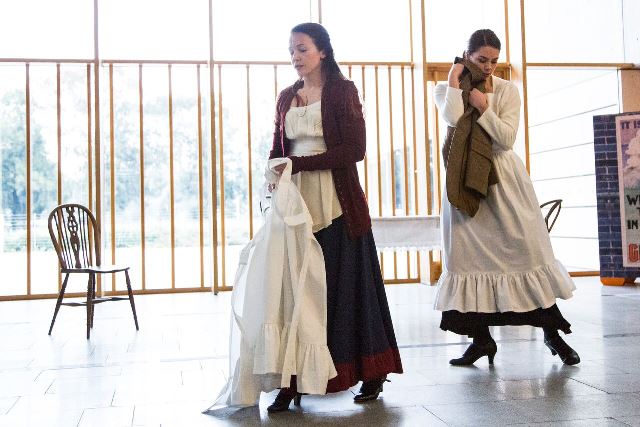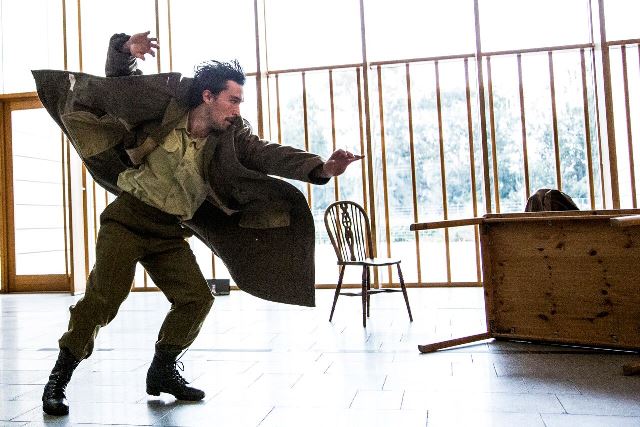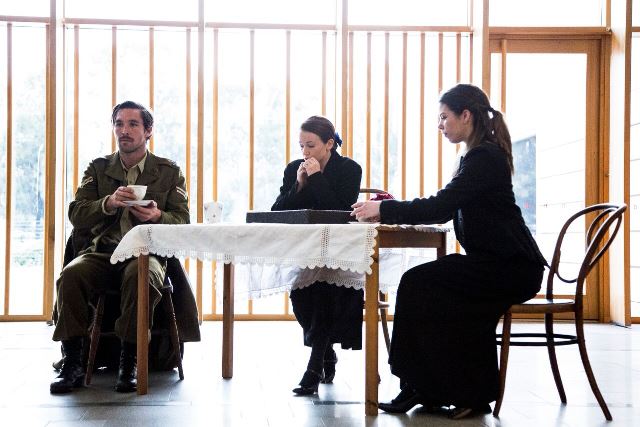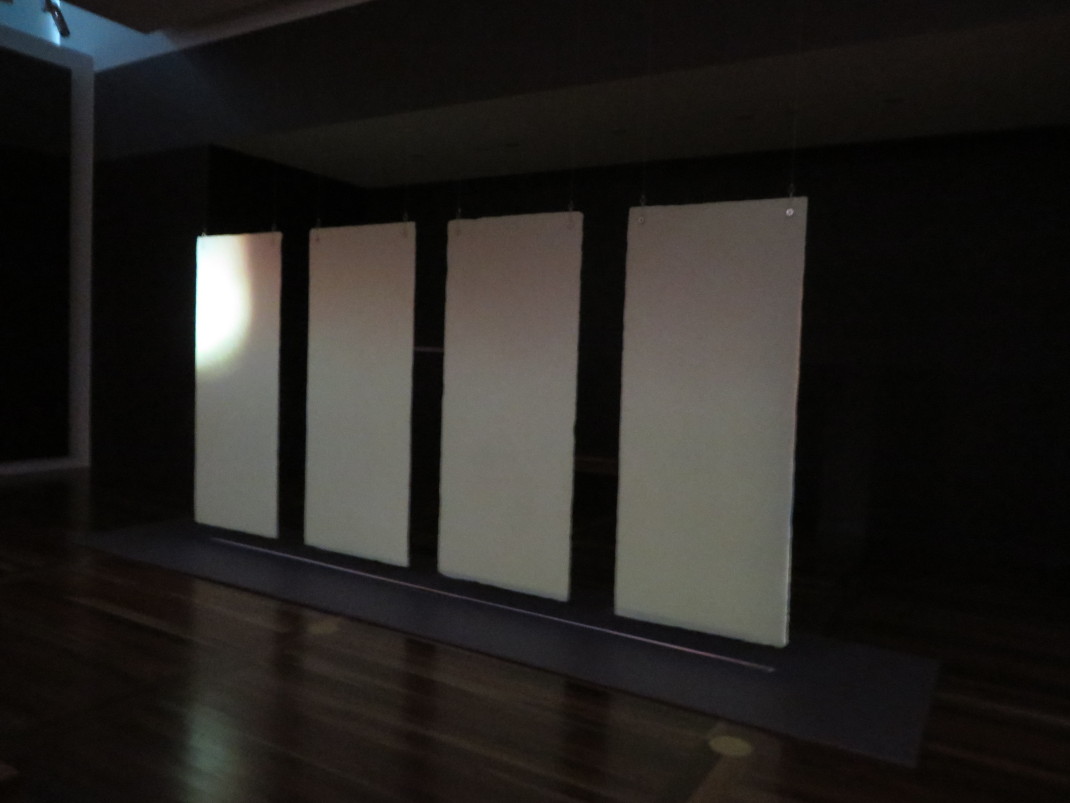10 July 2015, National Portrait Gallery, Canberra
Ruth Osborne, artistic director of QL2 Dance, has made a wonderfully moving vignette of dance for the National Portrait Gallery in Canberra. Called Walking and Falling, it features three beautifully costumed dancers, Dean Cross, Gemma Dawkins and Caitlin MacKenzie. All three are former Quantum Leapers who have gone from their student days with Canberra’s youth program to become professional dancers.
The work follows, in just 15 economical minutes, the life of a man who goes to war and returns shaken from the experience, unable to participate in the warmth of his family life as he could before he left. It opens with a charming scene around a table as the man and the two women in his life drink tea and eat scones to the sound of the patriotic wartime song Keep the Home Fires Burning. One of the women discovers a white feather in the pocket of the man’s jacket, but he does go off to war leaving the women to devote themselves to their daily chores. They pause often to think of him.

The scene shifts to the battle field and we see the man engaged in combat. Osborne has made smart use of the space available to her and of the simple props that she uses—a table, three chairs and a poster on a side wall. The table from that opening family meal of tea and scones becomes a form of shelter and protection for the man at war and it divides the small foyer area in which the dance unfolds into two separate spaces. There is one particularly poignant moment when the man shelters behind the overturned table to read a letter from home. On the other side of the table one of the women writes a letter and, in a flash, we see two worlds.

The man returns home, physically anyway. But he is emotionally scarred. The work closes as it began around the family table, but there is no longer the joyous engagement between the three. To the sound of And the Band Played Waltzing Matilda, a song on the futility of war, we watch as emotional silence engulfs the small group, a group that was once filled with life.
What is so attractive about this work is its simplicity. It achieves its huge emotional impact without any fuss or unnecessary razzamatazz. It moves smoothly from segment to segment and demands our attention from opening minute to its closing scene. All three dancers convey their thoughts and hopes strongly through movement, gesture, and eye contact with each other, or lack of it at the end as they struggle to cope with what has happened. As the work closes, we are left with an aching heart for the man, for the women in his life, and for their indescribable loss.
Walking and Falling is a tiny pearl of a dance commissioned by the National Portrait Gallery to accompany its exhibition, All that Fall, which examines sacrifice, life and loss during World War I. The exhibition couldn’t have a more perfect addition than Walking and Falling. Bouquets to Osborne and the dancers.
Michelle Potter, 11 July 2015
Featured image: Dean Cross, Caitlin MacKenzie and Gemma Dawkins in the closing scene of Walking and Falling, 2015. Photo: © Lorna Sim

Postscript:
The Portrait Gallery exhibition contains a collection of items from World War I including posters, personal mementos, and art works of various kinds. One of the most moving items is a work, also commissioned especially for the exhibition, by Canberra-based artist Ellis Hutch. She has created an installation of wax panels and light projections as a contemporary response to an uncompleted World War I memorial. The proposal and design for the original memorial was prepared by Theodora Cowen* and it was meant to honour the men who fell in World War I.

* There seems to be some controversy about the spelling of Theodora Cowen’s last name. Is it Cowen or Cowan? I have gone with the spelling used by the Portrait Gallery.
Hi Michelle, thank you for a wonderful empathetic review. With regard to the contemporary commissions, we have just posted edited versions of interviews with all three, including Ellis Hutch, on the website: http://www.portrait.gov.au/content/artist-interviews-all-that-fall
You might enjoy these.
Hi Anne
First, bouquets too to the NPG for commissioning a dance work. I have seen a lot of dance in galleries around the world, including the Tate Modern where I saw some wonderful Trisha Brown pieces, and most recently at the new Whitney in New York where, by chance, I was there when a Merce Cunningham dance from 1960 was being restaged. (And of course many in Canberra at our various cultural institutions). All have been more than interesting, and many have been in response to art on the walls. But few have gone beyond that and been truly inspired by the wider concepts behind an exhibition.
I loved that Walking and Falling inspired me to go into the exhibition space. I guess I was especially taken by the Ellis Hutch installation because it was so contemplative. It reminded me of Eva Hesse and Mark Rothko mixed together (not too outrageous a thought, I hope).
All that aside, there is so little truly professional dance emerging from Canberra at the moment that it was especially good to see Walking and Falling. The dancers were professionals so they could handle reasonably complex dance vocabulary (youth and community groups can’t do this). They were also dressed beautifully, which I really appreciated. The rest I have said in my post.
One thing, Theodora Cowen/Cowan is not an artist with whom I am familiar. What is the correct spelling of her name?
Thanks for providing the link.
Gemma Dawkins is my lovely and talented grandaughter she works very hard and I am proud of what she has achieved!
Lovely comment Sheila. All three dancers were exceptional.